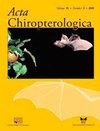与哥伦比亚热带干燥森林湿地利用相关的蝙蝠功能特征
IF 0.7
4区 生物学
Q4 ZOOLOGY
引用次数: 3
摘要
蝙蝠在湿地中发挥着重要的功能;了解蝙蝠的功能特征如何取决于环境特征,可以促进生态系统及其服务的管理。在这项研究中,我们调查了哥伦比亚跨安第斯热带干林湿地中蝙蝠功能多样性如何受到不同人为影响。具体而言,我们分析了不同的功能特征如何应对不断变化的环境条件、土地利用和土地覆盖模式。我们在2014年至2018年水文循环的干旱期对六个湿地进行了采样,并将功能多样性建模为环境变量的函数。为了了解蝙蝠群落结构与环境变量和生物因素的关系,我们将RLQ分析和第四角方法相结合,将环境特征和物种特征联系起来。当使用物种的相对丰度进行分析时,发现水面面积和牧场的百分比与蝙蝠的一般特征有关。此外,功能多样性的变化似乎主要是由较大的物种(如Phyllostomus hastatus、Artibeus lituratus)驱动的,它们的存在主要与异质区域有关。第四角分析显示,头骨的最大长度是最能描述蝙蝠在牧场、水体和高丰度灌木Vismia sp.和Cecropia sp.中存在的特征。这些结果表明,特定特征的组合是湿地之间功能多样性变化的重要驱动因素。考虑到哥伦比亚湿地的高度脆弱性,我们的研究结果为制定湿地生物多样性监测战略提供了基本信息。研究结果可以帮助确定优先保护地点,并改善环境决策。本文章由计算机程序翻译,如有差异,请以英文原文为准。
Functional Traits of Bats Associated with the Use of Wetlands in Colombian Tropical Dry Forests
Bats have a major functional role in wetlands; understanding how functional traits of bats depend on environmental characteristics can facilitate management of ecosystems and their services. In this study, we investigated how bat functional diversity has been affected by different anthropogenic impacts in wetlands of the Trans-Andean tropical dry forest of Colombia. Specifically, we analyzed how different functional traits responded to changing environmental conditions and land use and land cover patterns. We sampled six wetlands during the dry periods of the hydrological cycle from 2014 to 2018 and modeled the functional diversity as a function of environmental variables. To understand the association of bat community structure with environmental variables and biotic factors, we combined the RLQ analysis and the fourth-corner approach to relate environmental characteristics and species traits. The percentages of water surface area and pasture land were found to be associated with the general traits of bats when analyzed using the relative abundance of species. In addition, changes in functional diversity appeared to be driven mainly by larger species (e.g., Phyllostomus hastatus, Artibeus lituratus), whose presence was primarily associated with heterogeneous areas. The fourth-corner analysis revealed that the greatest length of skull is the trait that best describes the presence of bats in landscapes of pastures, water bodies, and high abundance of the shrubs Vismia sp. and Cecropia sp. These results suggest that combinations of specific features are important drivers of variation in functional diversity between wetlands. Considering the high vulnerability of Colombian wetlands, our findings provide fundamental information for the development of strategies for monitoring wetland biodiversity. The results can help identify priority conservation sites and improve environmental decision making.
求助全文
通过发布文献求助,成功后即可免费获取论文全文。
去求助
来源期刊

Acta Chiropterologica
生物-动物学
CiteScore
2.50
自引率
20.00%
发文量
42
审稿时长
>12 weeks
期刊介绍:
Acta Chiropterologica, published by the Museum and Institute of Zoology at the Polish Academy of Sciences, is devoted solely to the study and discussion of bats.
 求助内容:
求助内容: 应助结果提醒方式:
应助结果提醒方式:


